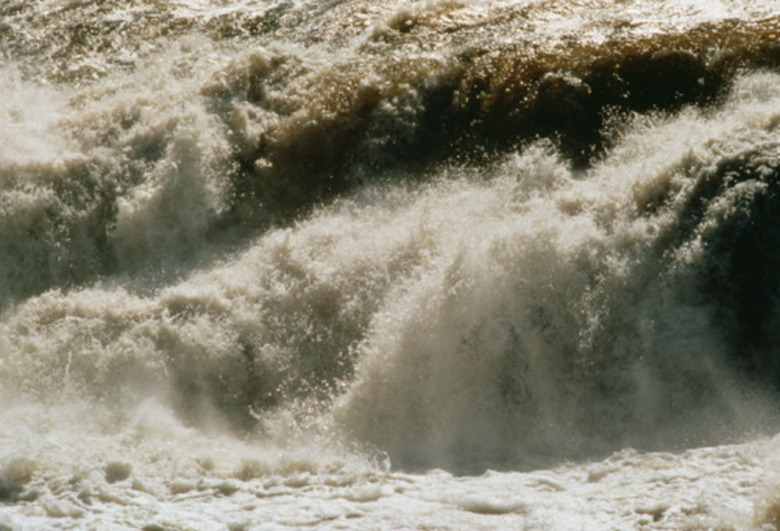Simple Weathering & Erosion Experiments For Third Grade
Introducing science experiments during the elementary years is important in order to capture a child's natural curiosity, while also building critical thinking skills and understanding of the scientific process. Weathering and erosion are concepts students can readily identify with, and with simple experiments students can make the connections to this natural process on a larger scale.There are many simple experiments for third-grade students which can demonstrate the natural actions of the effects of weathering and erosion upon the earth.
Acid Rain
Acid Rain
Attributes of weathering can be found throughout a third-grade student's environment. Introduce a student to what increases weathering, such as acid rain, which changes a material over time. In order to simulate acid rain, use a water solution containing vinegar. Provide students with background information on how acidity levels in the environment breaks down natural material such as rock. To demonstrate this, have students keep an observational log on the effect of acid on limestone. Provide students with a small chunk of limestone and a cup of water infused with 4 tablespoons vinegar. Provide them with a second bit of limestone and a cup of plain water. Submerge the chunk of limestone in each cup. At specified intervals have students observe the limestone in both cups and record their findings. Sediment (or weathering of the limestone) should be noted at the bottom of the acid-laden cup. Discuss how acidic-based water breaks down rock and have students make connections to the greater implications of acid rain upon larger rock formations.
Solar Weathering
Solar Weathering
The heating of the sun upon rock, and the cooling of rain and snow, causes the weathering and breakdown of rock. Using a Bunsen burner and a bucket of cold water, replicate this process. Because the rock reaches high temperatures, the teacher should carry out this experiment for students as a demonstration. Students can hypothesize, record results and make connections to the environmental process. Make sure to wear safety goggles as you carry out this experiment. Pick up a small piece of granite with tongs and hold over the blue flame of a Bunsen burner until the rock glows with heat. Next, plunge the heated rock into a bucket of cold water. Leave the rock in the water until it cools completely and then remove. Have students observe what is left in the bottom of the bucket. They should see some rock sediment. Have them observe the rock and write their observations of change. Repeat the process, demonstrating the weathering of rock due to sun and rain over time.
Temperature-Effect Experiment
Temperature-Effect Experiment
Discuss with students how water seeps into the crack and crevices of wood and rock. Further explain how freezing temperatures cause liquid to expand. This process breaks down rock and wood matter over time.
Have students fill a small, clear plastic gravy separator, filling it with water up to the spout. Freeze the container. The next day, have students observe the container. The temperature drop and freezing should force the water up into the spout, demonstrating expansion. Relate this to the action of water, rain and snow which enters the crevices of rock or wood, freezing and expanding the materials,eventually breaking them down into smaller pieces.
Water-Erosion Experiment
Water-Erosion Experiment
Erosion occurs from the weathering aspect of land formation, as the smaller particles are moved from one location to another. Explain to students that this can be caused by wind or water over a period of time, or suddenly due to weather conditions. An example of this would be the sudden erosion of the coastline of Louisiana after Hurricane Katrina. Showing students a coastal map of the Gulf coast region before and after the storm will demonstrate this. As an experiment, students can create a simulated land form and see how water (rain or flooding) can erode and reshape the land. Have students pack down sand into the bottom of a paint tray. Next, using a watering can, have students slightly sprinkle water on the packed sand and discuss what they are observing. The water should move the sand a bit. Next, have students pour the water. Sand should move down the slope of the paint tray, simulating land erosion. Explain to students the process of heavy rains upon land with the interaction of gravity, moving matter down slope
Cite This Article
MLA
Carpenter, Laurie. "Simple Weathering & Erosion Experiments For Third Grade" sciencing.com, https://www.sciencing.com/simple-erosion-experiments-third-grade-8653411/. 24 April 2017.
APA
Carpenter, Laurie. (2017, April 24). Simple Weathering & Erosion Experiments For Third Grade. sciencing.com. Retrieved from https://www.sciencing.com/simple-erosion-experiments-third-grade-8653411/
Chicago
Carpenter, Laurie. Simple Weathering & Erosion Experiments For Third Grade last modified August 30, 2022. https://www.sciencing.com/simple-erosion-experiments-third-grade-8653411/


